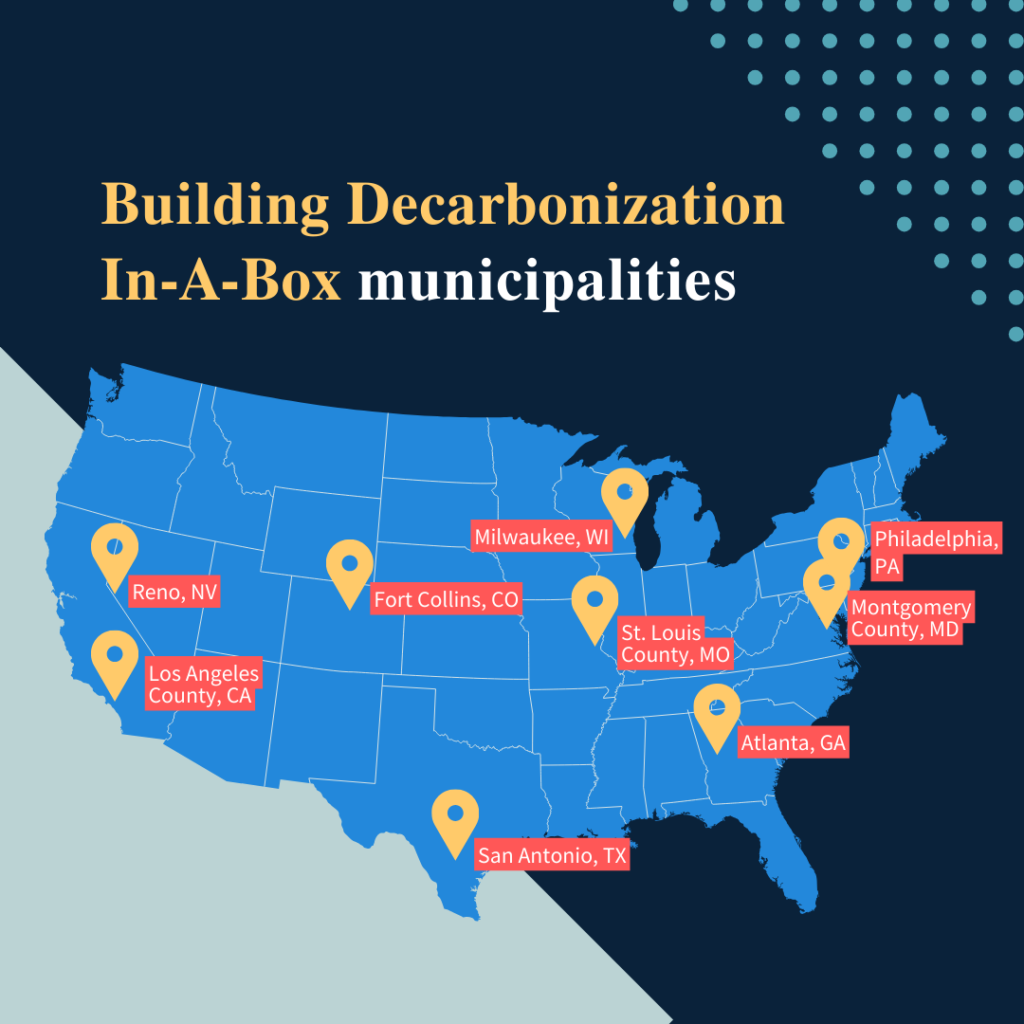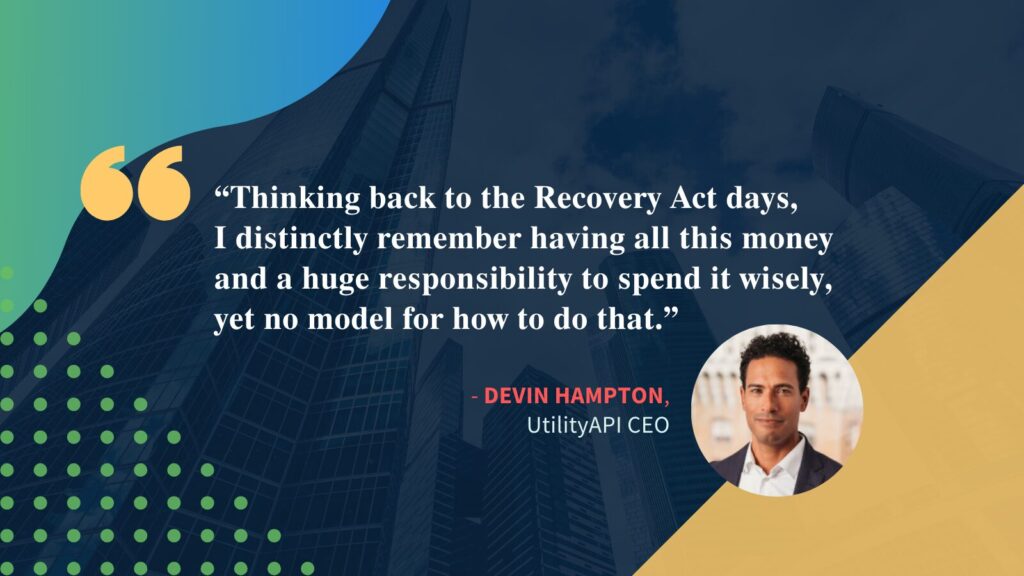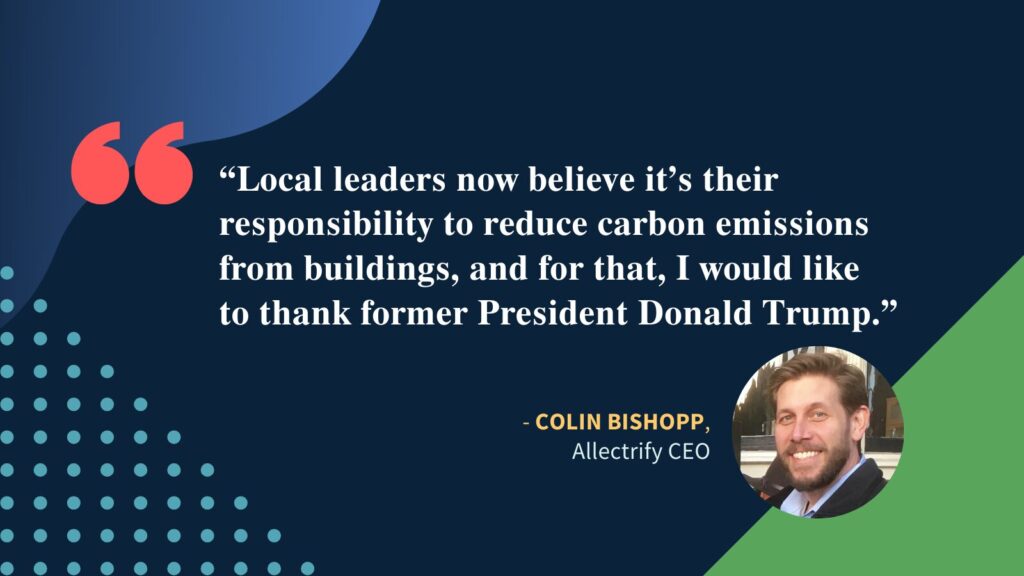Our innovative plan to tackle the climate impact of small buildings

Launching a local government-driven pilot program to accelerate building decarbonization in eight major US cities and counties is no small feat.
Building Decarbonization In-A-Box unites the public, private, and nonprofit sectors to target an often-overlooked segment: small commercial and multifamily buildings. The team will provide data access, analysis, and technical and financial assistance to identify underperforming buildings and help local governments make meaningful progress on this challenging sector.
UtilityAPI CEO Devin Hampton and Allectrify CEO Colin Bishopp discuss the origins of BDAB, their goals, and why we can thank Donald Trump for a little bit of the inspiration.

How did you come up with the idea for this ambitious project?
Colin Bishopp: About a year and a half ago, I started talking to Devin and others because the Inflation Reduction Act had just passed, and we knew there was going to be a lot of funding to decarbonize buildings. Having worked at the Department of Energy after passage of the Recovery Act, we had seen communities try lots of different approaches to use federal funding – some succeeded and a lot failed.
One of the things we learned is that the most cost-effective programs are market-based and leverage data in some way. Part of the reason I reached out to Devin is that utility data, or lack of access to it, created friction for building owners. If it’s too much of a pain for a building owner to do a comprehensive energy upgrade, they won’t do it. That’s one of the problems UtilityAPI solves: it makes it much easier for building owners and contractors to do upgrades.
And Devin, what made you want to say yes?
Devin Hampton: Thinking back to the Recovery Act days, I distinctly remember having all this money and a huge responsibility to spend it wisely, yet no model for how to do that. So, something I was really drawn to was this idea that there’s a large portion of buildings that are being left behind and if we’re really going to have an impact, that’s exactly where we have to go. It was a no-brainer.

What’s the significance of having Elemental Excelerator’s support?
DH: Elemental is a unique organization, in that they understand what cities and governments need for successful programming, but they just as equally understand what startups and innovative companies need to be able to provide services to those organizations. I don’t know anybody else who does a better job of understanding both sides. That perspective enabled them to develop the financing to kickstart this program. They solved the classic “cold start” problem – with their catalytic funding, the machine whirs to life and we are able to grow it from here.
CB: One of the things I really appreciate about Elemental Excelerator is how clear they are about what’s required to achieve all the goals of building decarbonization. It’s not just about reducing carbon emissions; it’s about creating jobs, lowering energy costs, and investing in the revitalization of our cities and towns. None of that is possible until you have a pipeline of real buildings that are ready to be upgraded. Once you have a pipeline, lenders will show up and offer financing. Access to financing means contractors are getting paid and can hire new employees. Training and apprenticeship programs can teach people to do that work. All of the other benefits flow from there.
You mentioned starting with data – what are some of the other learnings you’ve intentionally integrated into this project?
CB: An early grant from the Rockefeller Brothers Fund allowed us to consult lots of experts, like fellow veterans of the Recovery Act, the Building Energy Exchange in Kansas City, the New York City Accelerator, and the Colorado C-PACE program. We wanted to know what smaller cities and counties can do to attract federal funding and private investment for building upgrades. It turns out municipalities across the country have decades worth of building permit data, which can be used to identify the buildings with underperforming or about-to-fail energy equipment. Rather than attempting to reach every building owner, we can offer targeted assistance to those most likely to need an upgrade that year. If we can maximize that opportunity, then over the next 10 years or so, we can begin to decarbonize entire cities.
DH: One thing that was always a sticking point for me, while in government and now even outside of government, is when you ask a city or a large bureaucracy to do something new, it is so hard to get them to shift gears and buy in. Not just buy in, but then implement it and keep it moving. The inertia is real. What I like about the approach Colin is taking is to address that head on – let us give you a map for how to make this work and we’ll walk you through it.
This type of public-private partnership is rare. What’s going to help this one be successful?
CB: One of the things that’s unique about this is any city or county in the country can opt in – this isn’t just for New York City and L.A. Anybody who says yes is welcome.
I think this partnership is poised to take off because local leaders now believe it’s their responsibility to reduce carbon emissions from buildings, and for that, I would like to thank former President Donald Trump. When Trump removed the United States from the Paris Climate Accords, it put pressure on every mayor and county commission across the country to act. We’re now living in a country where local leaders are hyper-focused on this issue. Some of them have adopted building performance standards, some of them have adopted benchmarking policies, but many more are saying, “We’ve got to do something.”

Given your experience with the Recovery Act, what are you looking for in this initial phase? How will you know you’re on the right track?
DH: I hope this isn’t too obvious, but actual projects in actual buildings. Real results and the ability to show the results to cities that may think this is a good idea, but have been burned before and are a little hesitant.
CB: I think that’s exactly right. The proof is in the pudding. Are property owners actually being helped and actually upgrading their buildings?
It’s not necessarily in our best interest to point this out, but one of the strengths of this model is that other entrepreneurs and people can plug in. Once the cities and utilities understand, “Hey, by making this data more accessible, all of these things become possible,” other people are going to have smart ideas and figure out ways to plug in and increase the climate benefits.
DH: That’s right. We’re building this infrastructure. We’re just the first group of entrepreneurs to use it, but we will not be the last.
CB: Um, is it too late to also thank Joe Biden?
This interview has been edited and condensed for clarity.
